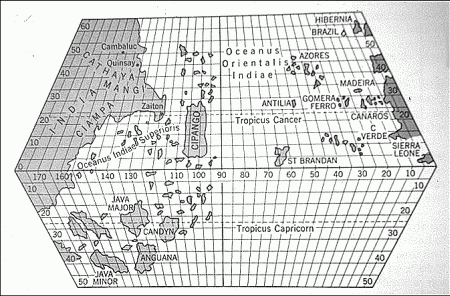|
|
|
|
|
|
|
|
"Everybody knows" that Columbus proved the world was round. Well, first
off, of course he proved no such thing: all he proved was that you could
reach some land by sailing west. Since that land wasn't Asia, he
certainly failed to prove his main point. But he wasn't even trying
to prove the world was round.
It is true that Columbus spent years in Spain and Portugal looking for a backer for his plan to reach the Indies (that is, East Asia) by sailing west, and had a hard time convincing anyone of its viability. It is true that he undertook debates with the academic/religious establishment (most famously at the University of Salamanca), and that the establishment always decided against him. But the debate wasn't over the shape of the Earth. Through all the Middle Ages, educated people knew the world was a sphere. Aristotle had proved it; the Venerable Bede, Roger Bacon, and Thomas Aquinas all affirmed it. The world-view of the Earth as the centermost sphere in a nested set - the "World as Onion" cosmology - permeated the academic disciplines of music, theology, grammar, and natural philosophy, as years of lectures at the University of Carolingia have illustrated. The myth that the medieval establishment believed the world was flat, that the Church taught it as dogma, was an invention of the 19th century - about as medieval as a steam engine. That wasn't what Columbus was arguing against. The argument was over the distance involved: how far west did you have to sail? This depended on three measurements: the distance (west to east) from Portugal to China, the number of degrees from Portugal to China (that is, proportionately how far around the globe), and the total circumference of the Earth. From these figures it would be simple to derive the crucial distance, that from Portugal westward to China. The first figure was roughly known at the time, from the writings of Marco Polo and other travellers, to be about 13,000 miles. But estimates for the other two measurements varied. Taking the extreme "worst-case" estimates, a total circumference of 24,000 miles (Fra Mauro, 1459) and an eastward extent of 116 degrees from Portugal to China (Catalan atlas, 1375), gives a westward distance of 14,000 miles - out of the question for sailing ships of the time, across open ocean without landfall or landmark. But Columbus argued a total circumference of only 18,000 miles (from the Florentine geographer Paolo Toscanelli, d. 1482), a whopping 225 degrees west-east (from the Imago Mundi of Pierre d'Ailly, c. 1410), plus a generous 1,500 miles from China east to Cipangu (i.e., Japan, from Toscanelli's reading of Marco Polo), for a result of only 3,500 miles west to Japan - difficult but not impossible. |
 Paolo Toscanelli's Map, 1474 (reconstruction, Hapgood) |
Home |
Usage |
Forums |
Articles |
Patterns |
Graphics |
Extras |
Contact Us


|